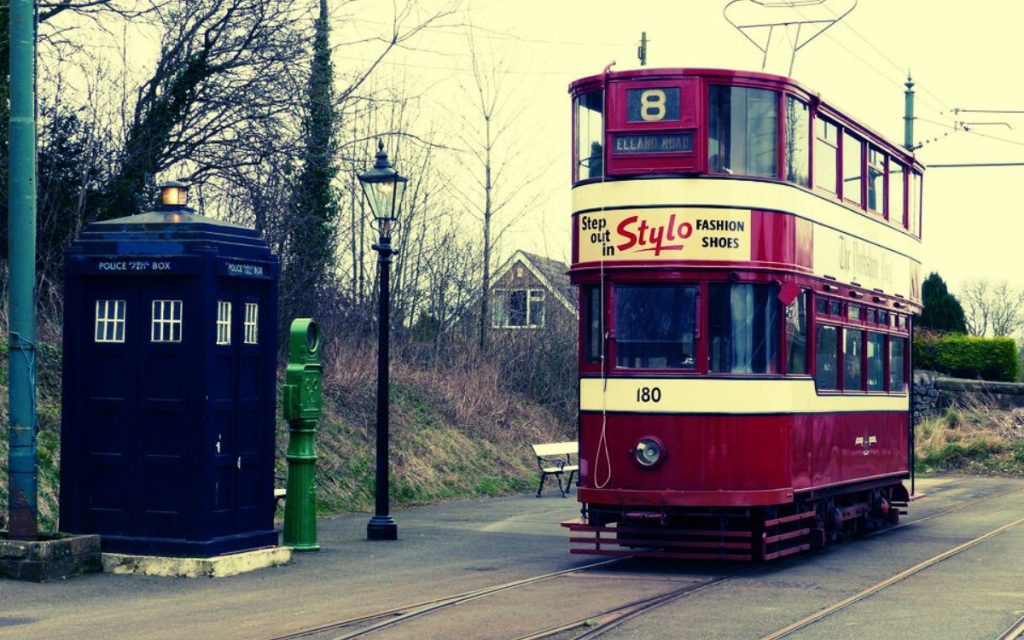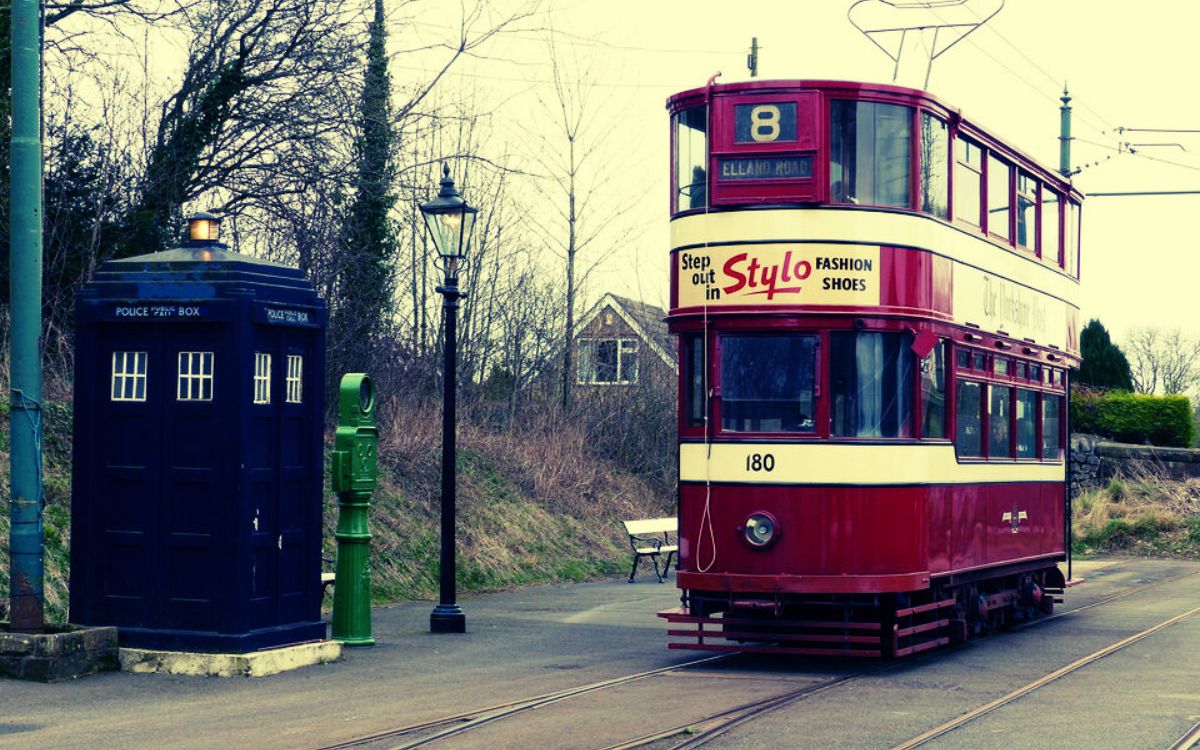A paranormal investigation at Crich Tramway Village has uncovered compelling ghostly encounters, from phantom tram conductors to spectral pub patrons, writes HUBERT HOBUX
Set deep in the heart of the White Peak District, a steep mile-long climb from Whatstandwell railway station, lies the historic Crich Tramway Village.
Since 1959, it has been the home of The Tramway Museum Society, who took the lease on an abandoned quarry and, through the dedicated blood, sweat and tears of volunteer members, began laying track and infrastructure on a site that had only a derelict workshop standing and one running tap.
The workshop was George Stephenson’s, erected in the 1840s for his Crich Cliff Quarry mineral railway.
Those providers of free muscle and support travelled from all over the country to help complete the dream.
Once the first trams started to arrive at Crich — Cardiff 131 and Leeds 180 — they were hurriedly sheltered beneath tarpaulin in thrown-together ‘lean-to’ sheds, and even deemed worthy enough to provide accommodation for the weekend volunteers to rest their weary bodies in.
All very “level-headed”, “pragmatic” people… quite a few of them did mention being “eerily disturbed in the middle of the night” (essentially on Leeds 180), by a ‘thick-set’ jacketed man in a trilby hat walking along the upper deck, who would disappear into the ether once berated for his inconsideration.
Thus began the haunted mythtory of Crich — one detail the Tramway curators kept close to their chests.
Even 60 years later, maintenance staff working alongside those well-preserved vehicles would still catch a glimpse of him walking the upper deck, when not a member of the public was allowed on that tram or in that area.
Indeed, no trace of anyone would ever be found on closer inspection.
A phantom conductor has reputedly made appearances too, inspecting his vintage tram car.
And a “laughing” ragamuffin child has been reported running between the large collection of trams parked in regimental rows in the massive, slightly eerie sheds.
So, at the tail end of September 2025, Crich Tramway Village granted Haunted Heritage limited access to the sheds and certain buildings to conduct the inaugural investigation into what ghosts may linger.
There were rumours of several different… but from whence might they stem?
The land has a lot of history, of course.
The quarry was old before, and fully working in 1791, when Benjamin Outram and Samuel Beresford bought Hilts Quarry to supply limestone for their new ironworks at Butterley, which they transported by means of gravity wagon railway and canal.
Strangely, even though you would think there would have been many casualties in the pursuit of that commodity, there is seemingly no (current) paranormal activity connected with the quarrying industry.
Buildings were brought in from various places to ‘dress’ the museum street scene.
As we know, if the stone tape theory is to be believed, spirits have a tendency to travel with the materials.

The façade of Derby Assembly Rooms was relocated following a fire in 1963.
That eighteenth-century building was reputedly well haunted in its day, and a phantom lady in Victorian dress is said to promenade the street as soon as the last visitors leave, strolling nonchalantly along the cobbles.
The Red Lion was dismantled brick by ceramic tile fascia from Stoke-on-Trent.
It was the site where a young delivery boy lost his life.
After having dropped off his despatch to the pub, the landlady gave him tuppence as reward and advised him to catch the tram home.
A steam tram — it seems he fell between the engine and tram trailer as he attempted to jump on board.
His mangled body was carried back into the Red Lion, where, sadly, he succumbed to his injuries in 1881.
Haunted Heritage are a very popular paranormal events company with a splendid reputation for professionalism and credibility.
Psychic mediums and favoured séance techniques are used, so results vary as to which group of guests ‘get’ which results. But when outcomes collate, it can be very interesting indeed.
What follows are the findings our group collected on the night.
We started in the museum display shed, calling out to any spirits conjoined to the trams or artefacts, with little to no response.
A few of us attempted to communicate by table tipping.
After a slow start, we made contact with a female “clippy” who eventually got the table activated with gusto and, with some cajoling, managed to staccato “walk” the table and us towards “her tram”—a Glaswegian fleet vehicle.
Meanwhile, two of our party had a strange experience behind a Sheffield tram car where they fell into hilarious laughing fits as if they were completely blotto.
Neither had been drinking, it must be stated, and as soon as they moved from the spot they returned to a more sober normality.
Another person had quite a shock as a large black bird flapped down at her from the high roof beams.
She ducked down for safety, but the bird vanished on approach.
No one else had seen any bird or bat in the interior.
The tram workshop was our next stop.
Upon entering the shed through the back door, we noticed a shadowy figure walking around the trams on the far side of the shed.
We shone our torches in its direction and called out for the “person” to identify themselves, but there was no one in sight.
The only museum staff on duty that night were escorting us around the exhibits. The staff member with us declared there should not have been anyone else in there.
We boarded tram 180 and sensed a dark presence had joined us.
Most were suffering feelings of apprehension, and headaches were reported.
An EVP session produced mumblings, but nothing we could discern.
Upon leaving the tram, the lady who had been scared by the “phantom flapping black bird” earlier got overtaken by some energy and had a minor panic attack, which involved her getting “stuck” to the front of the tram, refusing and unable to let go of it.
An energy circle had to be formed around her to ease the overwhelming spirit off her, and she did not fully recover until we had removed her out into the fresh air.
For many years, tram 180 operated on the No. 14 Stanningley–Corn Exchange route in Leeds.
In 1936, 180 was involved in a fatal collision involving a motorcycle combination and another tramcar.
The Red Lion pub was our last destination of the night.
Our journey terminated in the lower saloon bar, and we were soon conversing with several spirits in there, who flashed an electrical emergency light in response to questions, as well as activating REM pods and EMF meters.
Our museum escort could not explain why the ceiling light was acting in that manner and remarked he would have to get an electrician to check it the next day.
The spirits were urging us to go to the exhibition room upstairs, where a very interesting full round table séance was held.
At least three different residents of the Red Lion were identified and communicated with, and very similar results were matched with an earlier group’s findings at a later stage, which was quite rewarding in terms of verifying our energy-sapping efforts.
Strangely, both séances got a name for the young delivery lad — and an age for him — which we were informed was five years younger than the age given for him at his inquest.
In all, a remarkable night was had, considering that no paranormal events had been held at Crich before.
From past experience of going into an untouched venue, we have found that spirits are usually reticent in reaching out.
The experiences here will only ramp up the more they are approached, of course—and who knows, the old quarrymen might join the party also.
And so I will conclude by asking my usual question…
Is Crich Tramway Village haunted?
And answering it thusly…
Yes! You bet your bottom penny tram fare it is!
Have you experienced anything ghostly at Crich Tramway Village? Tell us in the comments section!
You can follow Hubert Hobux on on Twitter @HubertHobux and BlueSky @HubertHobux.



